 |
||
|
||
| ||
On March 12, 2003 Intel launched the Intel® Centrino(TM) mobile technology, the base for the new-generation mobile computers with wireless connection functions which grant more freedom and new network connection features for corporate and home users. The Intel Centrino technology is the most advanced Intel's solution for mobile PCs that includes a new processor for mobile PCs and new chipsets, and supports the 802.11 wireless network connection; all the components are optimized, tested and certified for joint operation. Beside the wireless connection means, the Intel Centrino includes functions increasing longer run-down time, slimmer design, lighter weight, and unprecedented performance in the mobile mode. "Unwiring the PC will change the way people use computers, allowing them to communicate, be productive or be entertained wherever and whenever they want," said Craig Barrett, Intel's chief executive officer. "Centrino marks the "first time we've put a combination of technologies under a single brand. This breakthrough innovation, together with industry-wide investment and WiFi hotspot deployments, brings new computing and communications capabilities to businesses and consumers, adding value to mobile PCs." The technology Intel Centrino exemplifies includes the Intel® Pentium® M processor, Intel® 855 chipset family and Intel® Pro/Wireless 2100 network interface. All the components are optimized and tested for joint operation in mobile systems.  The Intel Pentium M CPU is based on the new micro architecture optimized for mobile PCs which is more efficient, consumes less energy and runs longer with the batteries as compared to standard modern systems. The key features of the new micro architecture are: Micro-Ops Fusion for faster processing and lower power consumption, Advanced Instruction Prediction which reduces the overall latency for higher performance at the lower power consumption, and Dedicated Stack Manager which reduces the overall number of micro-ops to improve the performance at the lower power consumption. The processor utilizes Intel's advanced 0.13-micron technology and contains 77 M transistors. It's equipped with the low-voltage 400MHz system bus, 1MB L2 cache that disables blocks unused, and special functions for reducing platform's power consumption. The CPU supports the advanced Intel® SpeedStep® technology with several frequencies and voltage values, and Streaming SSE2 SIMD extensions. The Intel 855 family consists of two new chipsets developed for the mobile PC market: Intel 855PM chipset for an external graphics adapter, and Intel 855GM with the Intel® Extreme Graphics 2 technology supported. The new chipsets also support the Intel SpeedStep technology, Deeper Sleep mode and have an integrated self-timer that switches off the chipset's clock generator when it stands idle. The Intel 855GM also supports the low power consumption mode for the graphics subsystem. Both chipsets support I/O Hub architecture, up to 2 GB DDR 266 memory, USB 2.0 bus and have the 400MHz FSB. The Intel PRO/Wireless 2100 network interface developed is tested for full conformity with the Wi-Fi 802.11b access points. It incorporates powerful security features for wireless local networks including 802.11x, WEP and VPN technologies, with possible software upgrade up to WPA. Besides, the strategic partnership with Cisco Systems has brought into the Intel Centrino technology the Cisco* LEAP support with possible software upgrade up to Cisco* Compatible Extensions. The Intel PRO/Wireless 2100 network interface is tested for compatibility with equipment of the leading suppliers of VPN components (virtual private networks). The interface comes with the Intel® PROSet that targets ease of use and lower power consumption. It also incorporates Intel's technology that reduces interference between 802.11 equipment and some Bluetooth(TM) devices. The Centrino signifies Intel's entirely new approach. The "Intel® Centrino(TM) Mobile Technology brand is the first case when Intel applies a trade mark to a whole complex of technologies instead of a single processor. The company considers that high performance is not the only thing that a user of a mobile PC needs (as far as I remember, this is the first time when Intel admits that megahertz is not everything). Intel makes every effort to improve computer mobility for end-users. For this purpose they developed the program named Four Mobility Vectors covering performance, battery life, connectivity and form factor innovation. The concept of mobility means that all vectors work simultaneously. Implementation of this principle needs a completely new approach in design. To prove that the "Intel® Centrino(TM) for Mobile PCs Technology" is sustainable, Intel has verified if the complex of the mobile technologies serves the needs of end-users. The company joined 4 vectors mentioned above to create its best platform for mobile PCs. Intel actually started the platform from nothing. Undoubtedly, all large manufacturers announced models based on this technology. This month I've been testing exceptionally the Centrino based notebooks. So, let me start with the ASUS models (alphabetically and chronologically, as it was actually the first company to deliver production models). ASUS offers three Intel Centrino based solutions. 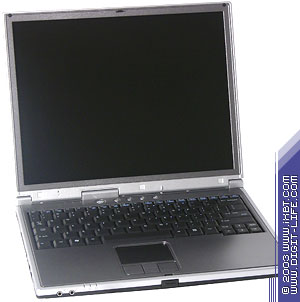 ASUS S1N is an ultraportable notebook that extends the S1 line. It's thin (less then 3 cm), light (1.9 kg) and elegant and can prove itself wherever you take it.  The ASUS M2N extends the M2 line and follows the S1N in style. The design is similar, though this model is larger. The ultrathin and light M2 is an alloy of flexibility, power and style created to satisfy the business people's needs.  The ASUS M3N is an entirely new model of the original design. The technical data of the models are similar as they are based on the same platform. Specification
Unfortunately, there is no information about the M3N at the international site, and the data are taken from http://www.asusnb.ru/. First impressions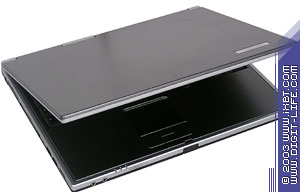 ASUS S1N  ASUS M3N The S1N and M2N models have ASUS's classical design. This style is familiar for those who deal with ASUS's notebooks or read our reviews. ASUS M3N is completely different. Its light gray colors, rounded corners and weird lid look unusual. Add the dark keyboard, the touchpad which can be seen only thanks to the frame, and the large power button surrounded with a blue glowing ring, - this model definitely has a touch of the youth style. 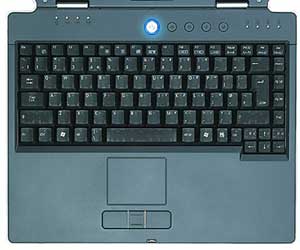 Some people may like it, but I prefer the classical design. Now let's have a look at their side panels. ASUS S1N ASUS M2N ASUS M3N The M3N has nothing but the latch there. Both S1N and M2N have indicators in front; also, the S1N has audio connectors on the left, and the M2N has the Audio DJ player controls. ASUS S1N ASUS M2N ASUS M3N All of them have LAN and Phone connectors, an external monitor connector, PortBar III and USB ports (one for the S1N and both for the M2N and M3N). Like in the earlier models, the connectors are poorly arranged. The experts at ASUS must know how difficult it must be to insert the AI-FLASH. Why is it solved on the small S1N, and not on the larger ones? On the other hand, they have a parallel port. On the M3N all unimportant connectors are protected with covers. The Kensington lock is on the right one the S1N, and on the left on the M2N.  ASUS S1N  ASUS M2N ASUS M3N As usual, here they have a PC Card connector, IEEE1394 and an IR port. The smallest model - S1N - has the power supply unit connector, AI-BOX connector (under the lid) and two USB ports! Why not on the larger models? There must be enough space. I understand that the processor with the cooler is located in the right-hand back corner. And I understand that the S1N has empty space on the right. But I can't understand what keeps them from cramming a USB port somewhere there. I address it to all notebook makers. ASUS M2N ASUS M3N The S1N has nothing interesting on the right, and the other two models sport an optical drive here, audio connectors and a power supply unit connector. Well, there must be no difficulties in handling the notebooks. And the S1N is arranged best of all. ErgonomicsIn the ASUS L3S review I wrote that the keyboard and application shortcut buttons are standard. Traditionally, it's hard to discern what's written on the shortcut buttons, but I remember them by heart :). Now have a look at the photos. 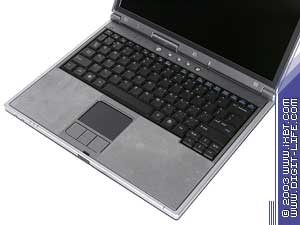 ASUS S1N 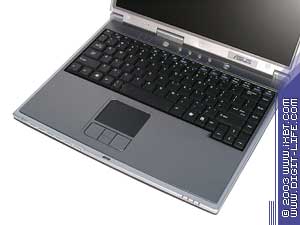 ASUS M2N  ASUS M3N The S1N and the M2N are like twins, only different in size. The M3N is of the different color, but all the rest is the same :). That's a right approach - user who are going to replace their computers will, most probably, buy a new computer similar to their old one. The only downside in the M2N is that the LEDs located in the lower right-hand corner can hide under your right hand. However, they are much more precious when the lid is closed than when you are working.  The S1N leaves the same impression. The only difference is its dimensions. If you don't use control buttons and touchpad much, it's like working on the other two models. But if it's necessary to move fingers a lot (Ctrl+Shift+something else and moving the pointer), the computer size tells immediately. The first thing that attracted my attention on the M3N is its touchpad. It looks like a fake one :)  Without installation of the drivers the pointer didn't work properly. We solved the problem by installing the drivers supplied with the computer, but then another problem popped up - sometimes the touchpad didn't recognize a left-button click. Besides, the fact that two touchpad buttons were replaced with a single swing one made the device less handy. However, I liked how the LEDs are arranged. 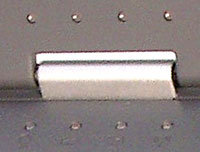 The LEDs can be seen even if the upper panel is closed thanks to the optical paths that bring the light out. Unfortunately, the wireless networks are not well developed on our local market, and I couldn't feel all the advantages of the new computers. However, it's possible that the advent of the Centrino platform will be a catalyst for deployment of the wireless networks. The new computers equipped with the wireless connection means arriving now in huge numbers must foster development in the wireless networking sphere. Now a couple of words for those who are going to get a Centrino based computer (not only ASUS) and install an OS themselves. The system must detect a new processor. It can be done with the HotFix Q332179, but only manually. You have to select the driver yourself (Update Driver -> Install from a list or specific location -> Don't search. I will choose the driver to install -> Have disk).  Now you can start working. However, I recommend that you install one more useful HotFix - Q330512 which adjusts the CPU performance on switching from the battery feeding to the line supply. But it's easy to install this one. Warranty and serviceThe warranty period for all ASUS's notebooks is 2 years since February 2002. The warranty is international. The online support works promptly. SiteThe Taiwanese site is excellent. It's comprehensible, the descriptions of the models are clear, detailed and illustrated. The base of drivers and BIOS updates is provided. ModernizationYou can replace the processor and hard drive and extend the RAM size, but you'd better do it in the service center during the warranty period. TestsWhat should we expect from the new platform. According to Intel's announcement,
it must run longer and have comparable performance at least. But the increased
cache size must boost the performance with the clock speeds being the same.
The Spec CPU 2000 test results will soon be published separately, and now
have a look at the standard notebook tests. Here are three models for comparison.
The choice is clear - we have taken mobile processors from Intel and AMD with similar clock speeds (or rating) and a desktop processor of a much higher frequency. The graphics is integrated everywhere, the video memory is as maximum as possible. The diagrams show the scores of the ASUS M2N. First of all, let's test the run-down life. The power management settings
are quite complicated. You can change the respective settings in the BIOS
(separately for the wireless connection as well), plus Power4 Gear, plus
drivers' settings of the wireless connection card. It comes to a wide choice
of potential modes. We set the auto mode in the BIOS, and disabled the
Power4 Gear utility and the wireless card.
The 5-hours level is reached! Besides, the diagrams prove that the Centrino platform has much better performance when runs on the batteries! The scores are brilliant! After that I tried to change the BIOS parameters
of the power management and enable the wireless connection on the ASUS
S1N. The Power4 Gear was left disabled. But the results are not that good.
When the power management is not activated, the performance grows, and the run-down time decreases. It's also clear that the wireless connection enabled worsens the performance without affecting the run-down time - the receiver and transmitter go on from time to time, search a network and then go off. What are the other two modes for is not clear - they look like the "battery optimised" mode but 2 minutes gained are not much. That is why I recommend the Auto mode - both the performance and the run-down time are perfect. But what if the Centrino based computer is connected to the power network?
It shouldn't have such a huge advantage. Let's see.
In the SysMark2002 the desktop processor takes the lead. Well, its frequency is still much higher. But the Centrino looks better than the competitors of its level. The Centrino is similar to the Athlon XP-M rather than to the P4 (Content Creation scores are much higher than Business scores). The results in the office applications are significantly better probably thanks to the big cache. Wonderful! Isn't it worth using the Centrino in desktop PCs? At least, the new platform is an absolute leader in the ZD Winstone. It runs 1.5 times better than the desktop Pentium 4 2.2GHz. Now comes the 3D graphics. I understand that we shouldn't expect much
from the integrated graphics, but I think the Centrino should look good
anyway.
Brilliant! Summary. General conclusion.The new Intel Centrino platform exceeded all my expectations. It's an excellent
mobile platform even without accounting for the wireless connection. The
performance and run-down time have reached a new level. Now I don't take
it sceptically that Intel aims to provide 8 hours of the run-down time.
As for the price, the ASUS S2N with the 1.3 GHz, 512MB memory and DVD/CD-RW
drive hovers around $1815.
Nikolai Dorofeev (niko@ixbt.com)
Write a comment below. No registration needed!
|
Platform · Video · Multimedia · Mobile · Other || About us & Privacy policy · Twitter · Facebook Copyright © Byrds Research & Publishing, Ltd., 1997–2011. All rights reserved. | ||||||||||||||||||||||||||||||||||||||||||||||||||||||||||||||||||||||||||||||||||||||||||||||||||||||||||||||||||||||||||||||||||||||||||||||||||||||||||||||||||||||||||||||||||||||||||||||||||||||||||||||||||||||||||||||||||||||||